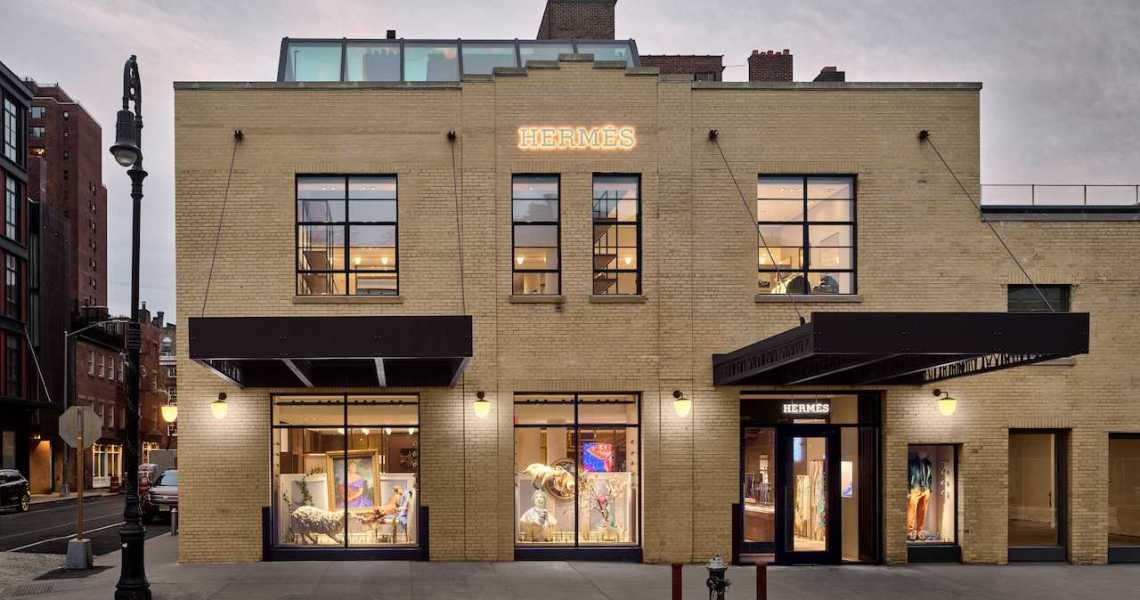When Diane von Furstenburg first moved her company to the Meatpacking District in Manhattan, the neighborhood was not the most ideal place for a luxury fashion brand.
“I moved to the Meatpacking District 20 years ago when I bought a small carriage house on West 12th Street,” said von Furstenberg. “I turned it into a design studio and showroom, and then added a mini shop in the small house next door. The neighborhood was run-down and not a typical location to drop in a fashion house, but I didn’t care.”
But since, a slew of fashion brands including Hermès, Madewell and Jeffrey have set up shop there, helping to restore the Meatpacking District as an area for fashion retail that can compete with SoHo and Hudson Yards. It had its heyday in the early 2000s, before brands like Stella McCartney and Moschino left the neighborhood. As brick-and-mortar retail continues to be an important factor for fashion brands, many brands are taking to the area — a welcome alternative to other, overstuffed neighborhoods in New York City.
While SoHo has become known as NYC’s neighborhood for experimental pop-ups and retail “experiences,” and Hudson Yards is establishing itself as the place for ultra-maximalist retail, Meatpacking has been quietly building up a reputation for a middle-of-the-road approach. It’s a place where you can find traditional high-end retail like Jeffrey next to an experimental pop-up from Loro Piana, which LVMH said in its recent earnings is driving a significant boost to the Loro Piana’s footwear category.
“For us, the idea was to offer our customers a bit more of an experience and not something traditional,” said Lauren Cardenas, gm of Sneakersnstuff, the European sneaker retailer that opened its first U.S. store in Meatpacking in 2017. “Meatpacking is a destination. You can go to SoHo and just walk around and bump into a lot of stores. But you go to Meatpacking because you live here or because there’s a particular store you want to go to. It’s like a mini 5th Avenue here.”
Cardenas estimates that about 50% of the customers that come through the store are tourists. Jeffrey Kalinsky, vp and designer fashion director at Nordstrom and founder of Jeffrey New York, the seminal fashion store that has been in Meatpacking for two decades, made a similar estimate. He guessed that half of Jeffrey visitors are tourists, 25% are from New York’s other boroughs and neighborhoods, and 25% are Meatpacking locals.
Part of the recent growth comes from favorable rent prices. Average rents in SoHo are around $540 per square foot per year, while in Meatpacking, they’re around $280. But Meatpacking’s success also comes from the public development designed to bring in more tourists and visitors.
In the beginning of August, the Meatpacking’s Business Improvement District will open the long-planned public plazas along Gansevoort Street and Ninth Avenue, after years of planning and development.
“The neighborhood first had significant capital reconstruction four years ago,” said Jeffrey LeFrancois, the executive director of the Meatpacking District Management Association. “This year, we will have all these historic plazas back, with tables, chairs, planters. As cities around the world know, public space is good for business. North of 20,000 square feet of public space will be made available. Right now, Meatpacking is in a moment of re-discovery.”
These projects to beautify and preserve the neighborhood’s historic locations have attracted a number of intriguing fashion brands, both old and new. Last April, Hermès opened a flagship store in Meatpacking, designed to pay tribute aesthetically to the neighborhood’s industrial heritage.
“Not long ago, you wouldn’t have mentioned Madison Avenue and the Meatpacking District in the same breath,” said Axel Dumas, CEO of Hermès. “Setting up shop in the Meatpacking District is an incredible source of energy for us, as well as a wonderful way to reconnect to our roots.”
DVF also chose to stay closely aligned with the neighborhood’s industrial vibe.
“Eventually, we outgrew our original space here, and that’s when I made the move to 14th and Washington Street,” von Furstenburg said. “The building needed to be historically preserved, so we saved the façade but created a beautifully bright, sunny interior.”
But Meatpacking hasn’t been without its struggles. Earlier this month, Milk Studios, the neighborhood’s iconic creative agency that has hosted countless fashion events and runway shows since the ’90s, abruptly announced that it will be leaving the neighborhood next year and that Google will be taking over the building. Google also acquired the building across the street from Milk last year. The influx of Google employees will likely be a contributing factor to the neighborhood’s continued growth.
“In the past 20 years, I’ve seen big changes,” said Kalinsky. “In the last five years, the most notable thing to happen was The Whitney reopening, and things like that certainly bring a lot of people in.”
While SoHo increasingly becomes the home of experimental retail and DTC shops, and Hudson Yards aims for ultra-luxury mall shopping, the brands that have called Meatpacking home have no plans to leave any time soon.
“Clearly I love this neighborhood, and I believe in this neighborhood,” said von Furstenburg. “I’m proud to have been witness to the evolution of this district.”




